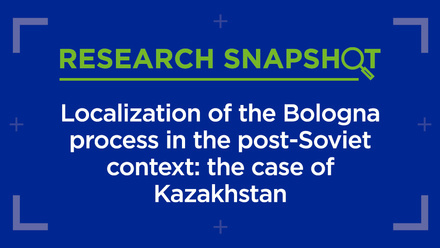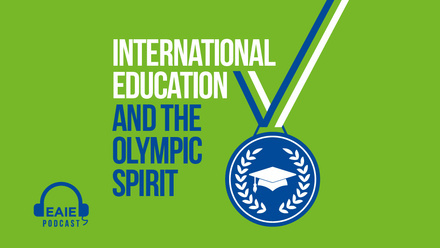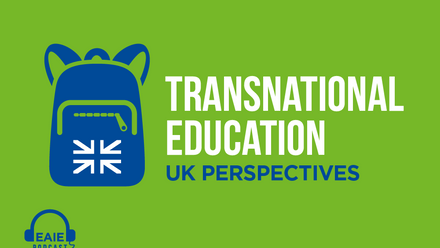The key elements of transnational education (TNE)
.jpg.jpg)
Higher education institutions get involved in internationalisation in different ways, for many different reasons. From routine student exchange programmes to cross-border collaborative arrangements, the most striking dimension of the internationalisation process has been its speed and variety. Growth has been particularly strong in the number of students studying in their home country with foreign higher education institutions operating outside of their own national space.
The market for ‘transnational education’ (TNE) has doubled in size since 2000 and continues to grow steadily. As higher education professionals with extensive experience in TNE, it is great to see a resurging interest in the nature and experience of TNE and focus our attention on its changing nature and impact.
Transnational education in a nutshell
For those less familiar with the concept, TNE is a complex mix of engagement activities occurring in culturally diverse markets, embracing both virtual and physical forms of cross-border education. It is distinct from the standard forms of international student mobility where a student from country X goes to study in country Y in order to undertake a degree or course of study, or where the international student is briefly mobile, eg on a semester-based exchange or short-term study programme. In the TNE space, we are concerned with educational service arrangements or courses of study, in which learners are located in a country different from the one where the awarding institution is based. Students experience their education, or some significant part of it, at distance from the home campus of the awarding institution.
A variety of forms of transnational education
As an illustration of one form of TNE, international franchises and validation agreements tie together institutions from different countries in contractual arrangements based on licence and/or mutual recognition. The aim of these is to enable students to study for the degree of a foreign university without being taught on the home campus of that university. The TNE student derives many advantages from staying at (or closer to) home but is unlikely to be taught by the core faculty of the supplying university, or to undertake a course of absolute equivalence to the one on the campus of the foreign university. In the validation model popularised by UK universities, there may merely be recognition of a degree which has been designed and taught elsewhere, so long as the quality of the degree is tested by the awarding institution. Other types of TNE arrangements such as twinning and articulation provide an element of this experience but generally require students to study on the home campus of the awarding university for at least part of the time. Here there are parallels to joint and dual degree education, where time is split between partner institutions ‘home and away’. International branch campuses and flying-faculty models are also part of the broad set of TNE engagement models. In these cases the awarding (foreign) university has either a direct or indirect presence in an overseas market. This may be either fixed or temporary. Over-and-above these familiar examples, distance and online education provide a virtual platform for students to study for the degree(s) of a foreign university. This is an increasingly popular way of delivering education internationally or transnationally and does not require the supplying university to establish a physical presence in its international markets.
Transnational education landscape and stakeholders
The TNE landscape is a complex one, with multiple stakeholders, each having different perceptions, expectations and motivations. Differing starting points and expectations have spawned a vibrant and diverse range of engagement models. Some have been more successful than others, but all have contributed to the rich fabric of international higher education and in most cases benefited their stakeholders either directly or indirectly.
For institutions looking to get involved in TNE or reassess their existing TNE arrangements, understanding stakeholder attitudes and how their context is reshaping perspectives is critical to ensuring a programme’s viability. It is now more important than ever to ensure that TNE programmes are aligned, not just to the strategic goals of the foreign degree provider, but also to the needs of the stakeholders in the hosting country. In their simplest form TNE stakeholders can be categorised into:
- Academic partners as providers
- Faculty and staff engaged in delivery (potentially across different institutions)
- Students and their families as consumers
- Government as enablers and regulators
- Employers and the community as beneficiaries
- Local institutions as potential competitors and collaborators
The needs and desires of each group are not necessarily aligned with the others’ and lots of boxes need to be ticked to make a TNE arrangement successful. Tension is likely to arise between the interests and objectives of different stakeholders and if not tension, points of misunderstanding and uncertainty. Those familiar with TNE projects will recognise the challenges in fully uniting these different stakeholders and/or engaging all of them fully in effective, sustainable TNE projects. Across this spectrum, stakeholder attitudes towards TNE are strongly influenced by:
- Their personal motivations
- Their perceived quality of local education provision
- Their experience of different types of TNE
- The economic development status of the country
Conclusions and signposts
TNE has produced many graduates who have subsequently entered the workforce, some of whom now hold senior management positions in government and private industry. Through these alumni, employers get more exposed to TNE programmes and the quality of their output. This is opening doors for greater industry engagement, which in turn can open up new opportunities to reshape stakeholder attitudes to TNE.
As some of the early TNE pioneers have discovered, their international arrangements are now resulting in unforeseen positive outcomes beyond those originally envisaged. The impacts of these developments are more immediate and apparent to stakeholders in the hosting countries, rather than to those associated with the home campus. Communicating these changes and navigating the new expectations arising from these outcomes make up a critical part of the maturing TNE arrangement. Sustainable TNE arrangements adapt to the changing environments in the host countries and those that adopt new forms of engagement and embrace evolving stakeholder needs, are most likely to benefit now and in the future.
If you want to gain an advanced understanding of TNE models and frameworks, learn how to identify key TNE stakeholders, increase your knowledge of competing perspectives on TNE and learn more about TNE landscapes and shifts in tertiary education, sign up now for the conference workshop ‘Delivering education abroad: how stakeholder attitudes are being reshaped’, taking place on 11 September at EAIE Istanbul 2013.
By Professor Simon Mercado, Professor of Global Management & Management Education at Nottingham Business School, Nottingham Trent University (UK) and Lorne Gibson, Convenor, TNE Special Interest Group, International Education Association Australia and Director, International Business and Partnerships at Deakin International, Deakin University (Australia).






